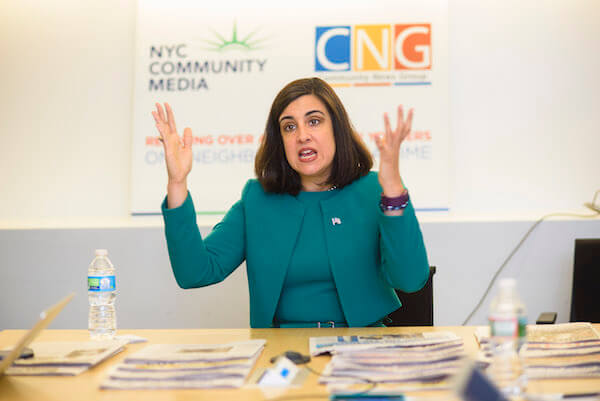Longtime gay activist Jim Fouratt and City Councilmember Margaret Chin at a December 12 City Hall rally in support of a senior housing facility on Elizabeth Street where SAGE would provide LGBTQ-inclusive services. | SARAH FERGUSON
A new constituency has joined a long-running battle over the future of the Elizabeth Street Garden in Little Italy: gay seniors.
The city targeted the garden for affordable housing five years ago, setting off a battle over a Lower Manhattan statuary that pits the needs of low-income seniors against the demand for green space in this dense urban pocket. New plans for the site unveiled two weeks ago described the proposed 121-unit residence as affordable, “LGBTQ-friendly” senior housing.
SAGE — or Services and Advocacy for GLBT Elders, the nation’s largest and oldest advocacy group for queer elders — would provide on-site services for residents in the proposed complex, as would the housing group Habitat for Humanity, which would move its New York City headquarters there.
Residence with 121 units, SAGE services set against longtime Little Italy garden in fierce tussle
The de Blasio administration clearly hopes the participation of the two groups — along with a pledge to preserve about one-third of the site as green space — will tip public opinion in favor of the proposed Haven Green development.
At a December 12 rally in support of the project, Councilmember Margaret Chin, the project’s lead sponsor, championed the needs of gay seniors.
“We have an opportunity before us to do the right thing for our seniors, including LGBTQ seniors of the Stonewall generation, the pioneers who fought in the face of insurmountable odds to make our city a place that welcomes all of us,” Chin told the crowd of about 30 supporters who gathered beneath the portico at City Hall to shelter from the rain.
Behind her, a supporter held a sign that proclaimed: “Housing for LGBT Seniors is a RIGHT!”
But whether the inclusion of SAGE and its community of advocates will sway those who support preserving the garden — including nearly every other elected official in Lower Manhattan — remains to be seen.
Rather than bending to the project’s critics, Mayor Bill de Blasio is making the Elizabeth Street site a showpiece for its new Housing New York 2.0 agenda, which includes fast-tracking the creation of senior housing on “underutilized public lots.”
“We are building a movement,” declared Michael Adams, SAGE’s executive director, speaking at the rally with Chin. “This is how we are going to make our city a city of equity.”
SAGE is already at work on two other LGBTQ-friendly senior housing residences — in Fort Greene, Brooklyn, and in Crotona Park in the Bronx.
Jim Fouratt, a gay activist for decades, congratulated Chin for standing up to opponents of the project.
“I’m part of the creative community that came to the Village in the ’50s and ’60s,” said Fouratt, who took part in the Stonewall uprising and later co-founded the club Danceteria.
“I live in a six-floor walkup, and for the past year and a half I’ve been in court with my new landlord,” he shouted, raising his fists. “I’m putting in for this lottery!”
Also lining up alongside Chin were the heads of several nonprofit groups serving seniors, including LiveOn NY and Vision Urbana, the latter which serves primarily low-income Latinos on the Lower East Side.
All spoke to the pent-up demand for affordable housing. Jackie Wong, director of operations at Chung Pak Local Development Corp, a rental building for low-income seniors in Chinatown, said when his company opened the waiting list for apartments there last August, it received more than 7,000 applications.
Clearly the need for more senior housing is urgent, but to the project’s critics the question is why such housing should be built atop a much loved, community-run park.
“This is a false choice,” declared City Comptroller Scott Stringer, speaking out at a rally called the previous day by the two nonprofit groups fighting to preserve the Elizabeth Street Garden.
The day before the Chin-SAGE rally, Comptroller Scott Stringer and other elected officials joined supporters of the existing Elizabeth Street Garden. | SARAH FERGUSON
To about 75 garden supporters, also gathered outside City Hall, Stringer added, “Affordable housing cannot come at the expense of green public space.”
Remarking on the city’s insistent effort to build over the Little Italy garden even in the face of broad opposition from local residents and the repeated condemnation of Community Board 2, the comptroller told the crowd, “I’ve tried to struggle with why this is happening.”
Then, taking a swipe at the de Blasio administration’s record of using a top-down approach in siting new developments, Stringer said, “We have to go back to being a city that does community-based planning. We are not accounting for the numbers of amazing children that are coming to Lower Manhattan. These kids need a place to play.”
Public Advocate Letitia James was equally emphatic.
“It is a false choice, it is a Hobson’s choice, and it’s a false dichotomy,” she said. “We can do affordable housing — in fact, we can do more affordable housing,” alluding to CB2’s call for shifting the project to an empty, city-owned lot on Hudson and Clarkson Streets in Hudson Square, where board says five times as much housing could be built.
“I’ve been to that garden and it is a peaceful place,” James told the crowd. “And I say, the fight is not over. Mr. Mayor, when I tell you the fight is not over, you know I mean it!”
Among the other officials on hand to support the garden were State Senator Brian Kavanagh and Assemblymember Yuh-Line Niou, who said the Little Italy area was already woefully underserved with open space.
“Everyone supports affordable housing,” Niou said. “But we can’t be always asking for affordable housing to the point that we make it unlivable.”
None of those politicians standing with Stringer on December 11, however, will get to vote on the project as it goes through the city’s Uniform Land-Use Review Process, or ULURP. To move forward, the project must be approved by the City Planning Commission and the City Council, which tends to follow the lead of the councilmember in whose district the project falls — in this case, Chin.
The community board and Manhattan borough president have only advisory votes, although the borough president can force a supermajority vote if she votes “no.” Thus far, Gale Brewer — who’s been a steadfast ally of Chin on other issues — has been noncommittal on the Elizabeth Street site.
In a press release, the city’s Department of Housing Preservation and Development pledged to “recreate many of the existing features and layout of the site, including passive spaces, sculptures and art pieces, lawns, diverse plantings, space for gardening, and open seating.”
But garden advocates say the current proposal, placing the seven-story residential complex on the Elizabeth Street side of the garden and shifting the open space to the Mott Street side, would result in a public lawn that’s mostly in shadow.
“There will not be one blade of grass in the garden that’s proposed, so this is a sham” scoffed Kent Barwick, the former president of the Municipal Art Society, who lives on Mott Street.
“It’s another concrete slab with benches,” charged local mom Emily Hellstrom, one of the founders of Friends of the Elizabeth Street Garden. “We’ve found a gravel-strewn lot could provide five times as much housing. Why are we being cast as the villains?”
Chin, however, argued that both locations could be utilized to expand senior housing availability, saying, “That’s not an alternative site, but an additional one. The need for senior housing is so great. We need both.”




































